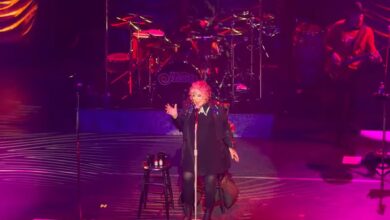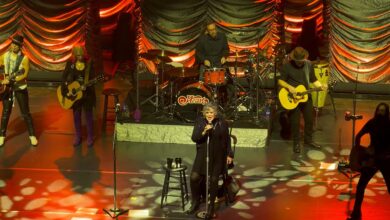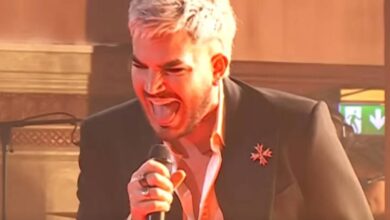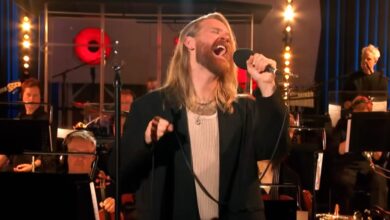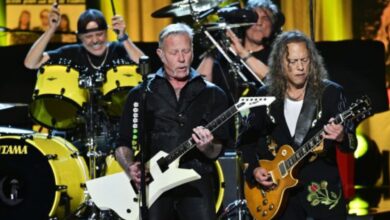AC/DC Detonate Melbourne with a Fiercely Explosive “Shoot to Thrill” on November 16, 2025
On Sunday 16 November 2025, Melbourne Cricket Ground did not feel like a sports stadium anymore; it felt like a pressure cooker the whole city had been slowly heating all week. AC/DC were back for their second Melbourne Power Up show, and everyone walking up Brunton Avenue knew they were stepping into something bigger than just another tour date. The first night had already made headlines, so this felt like a rematch between the band and an 80,000-strong crowd determined to scream even louder.
All day, the suburbs fed into the city in waves of black T-shirts, denim jackets, and sun-faded Back in Black logos that had clearly been to more than one gig. Fans swapped stories about the Wednesday show—how Jailbreak had come roaring back into the set for the first time since the early nineties, how the stadium lights seemed to shake with every chorus. That mythology hung in the air as people queued for beers and merch, a challenge as much as a memory.
Inside the MCG, the stands filled slowly at first, then all at once. The sun slipped down behind the concrete bowl, painting the sky in orange and purple while the ground lights brightened in stages. Down on the field, the front standing area was already packed tight, a sea of nervous energy pressed against the barrier. Further back, whole groups of friends laid claim to their rows, draping jackets over seats and taking wide-angle selfies that tried and failed to capture just how huge the place really felt.
Before AC/DC even touched the stage, the night had its own narrative building. Local heroes The Casanovas opened, throwing chunky riffs into the cavernous space and warming up early arrivals. Then Amyl and the Sniffers stormed out, Amy Taylor charging up and down the runway like she owned it, her band channelling frantic pub-rock chaos into the kind of punch that actually works in a stadium. By the time they finished, the message was clear: Melbourne’s rock scene was not just alive, it was foaming at the mouth.
When the house lights dropped again around 8:30, the roar was instant and full-bodied, the sound of eighty thousand people surging to their feet at exactly the same moment. The opening strains of “If You Want Blood (You’ve Got It)” blasted out, and AC/DC appeared not as elder statesmen easing into nostalgia but as a band that still believed in kicking the door off its hinges. Brian Johnson strode on in his cap and sleeveless black, while Angus Young, still in that red schoolboy outfit, looked like a cartoon character who had simply refused to age.
The early part of the set felt like a series of body blows delivered with ruthless efficiency. “Back in Black” arrived second, its riff punching through the night air with the kind of authority only decades of repetition can give. “Demon Fire” and “Shot Down in Flames” followed, then “Thunderstruck” sent the lower stands into a jumping, chanting frenzy. By “Have a Drink on Me” and “Hells Bells,” the show had settled into that sweet spot where the band and crowd are no longer separate forces but part of the same machine.
Somewhere between the tolling of that giant bell and the defiant stomp of “Highway to Hell,” you could feel the evening tilt from “great show” into “this might be one of those nights people talk about for years.” Reports from the first Melbourne concert about earthquake-style readings on seismology monitors were already urban legend by this point, and you could sense thousands of feet slamming the concrete a little harder, as if trying to etch their own vibrations into the city’s memory, separate from Wednesday’s history-making opener.
Then came the moment that so many in the stadium had been quietly waiting for. As “Highway to Hell” crashed to a close and the stage lights shifted, Angus hit the first cutting notes of “Shoot to Thrill.” The transition felt almost cinematic, like flicking from one iconic chapter of the band’s history to another. The main riff screamed out across the MCG with the weight of an incoming freight train, instantly tightening the focus of the whole place onto that one serpentine line of guitar.
Brian leaned into “Shoot to Thrill” like a prizefighter who knows exactly when to throw a combination. His voice does not chase the same high notes it did in the early eighties, but on this night that worked in his favor. Each line came out with a rough, lived-in swagger, the delivery more about attitude and rhythmic punch than sheer range. As he prowled the front of the stage, pointing into pockets of the crowd and barking out choruses, it felt less like a performance and more like a call to arms.
Angus, meanwhile, turned the song into a masterclass in momentum. He duckwalked along the runway, hair flying, firing off riffs that never once lost their grip on the groove. During the instrumental breaks he toyed with the tension, stepping toward the edge of the stage and letting runs of notes spiral upward before snapping back into the tight, chugging backbone of the main progression. On the big screens, his face was a mask of total concentration and utter joy, the look of someone still addicted to the noise he’s making.
Behind them, the rest of the band did that uniquely AC/DC thing of making brutal simplicity sound like high art. Stevie Young’s rhythm guitar sat like a concrete wall behind Angus’s leads, every chord exactly where it needed to be. Chris Chaney’s bass rumbled underneath, gluing kick drum to guitar without ever demanding attention for itself. Matt Laug hammered the song’s heartbeat into the ground, his snare translating directly into thousands of fists punching the air in perfect synchronization.
Out in the stands, “Shoot to Thrill” seemed to reach people in who they had been, not just who they were in that moment. Middle-aged fans who had first blasted the song out of car stereos on cassette suddenly moved with the reckless energy of their teenage selves. Younger fans, raised on Marvel soundtracks and viral live clips, finally saw the song in three dimensions, vibrating through the concrete and steel of an actual stadium. Sections of the crowd turned into bouncing whirlpools, strangers locking shoulders and screaming lyrics into each other’s faces.
What made this performance stand out from countless other nights the band has played the song was the way it felt both razor-sharp and dangerously loose at the same time. The structure was tight—this is a band that has drilled these songs into its bones—but within that frame there was a crackling sense that anything could happen. Brian toyed with the phrasing, holding lines a fraction longer, while Angus extended little fills here and there, stretching the edges of the song without ever letting it come apart.
As the arrangement dropped down into its tense mid-section, the atmosphere inside the MCG shifted from explosive to almost ritual. The volume dipped just enough for individual voices to float above the noise, people whistling, clapping, and shouting for the next wave to hit. Angus milked those seconds of suspended energy, pacing slowly, teasing the return of the riff with tiny flurries of notes. For brief moments, the stadium existed in a kind of delicious free fall, hanging between what had just happened and what everyone knew was about to crash back in.
When the band finally slammed back into the full-tilt section of “Shoot to Thrill,” the release was almost physical. Lights strobed across the field, revealing faces twisted into grins and screams, and the floor area moved like a single living beast. The chorus hit with renewed force, louder than before, thousands of voices now hoarse but unwilling to back off. Even in the top tiers, where the band were small figures framed by giant screens, whole rows jumped as one, the MCG’s famous concrete steps turning into accidental percussion with every landing foot.
As the song powered toward its finish, you could feel an unspoken understanding rolling through the crowd: nobody knows how many more times they will get to see this lineup play this song on home soil. That realization did not make the moment melancholy; instead, it gave everything an added crackle of urgency. People sang louder, held their phones a little steadier to catch the last solo, and locked their eyes onto the stage with the kind of focus that comes from knowing you might be watching a final chapter being written in real time.
The last chord of “Shoot to Thrill” rang out like a held breath before turning into a roar of applause that seemed to go on forever. Brian tugged the brim of his cap toward the crowd, grinning as if he could not quite believe the noise, while Angus stood near the drum riser and let the guitar feed back in a long, controlled squeal. For many in the stands, this was the apex of the night, the song that somehow pulled fifty years of history, hype, and hometown pride into a single concentrated blast.
Of course, the show did not end there. “Sin City” followed, a knowing nod to the band’s Australian roots and the grubby glamour embedded in their early catalog. “Jailbreak” arrived again, now no longer a shock but still a heavy, emotional punch, as Bon Scott’s era resurfaced under the MCG lights. “Dirty Deeds Done Dirt Cheap,” “High Voltage,” and the newly added “Riff Raff,” “You Shook Me All Night Long,” and “Whole Lotta Rosie” kept the intensity pinned in place, leading into a breakneck “Let There Be Rock” that seemed determined to wring out every last drop of energy.
The encore felt like a coronation. “T.N.T.” turned the stadium into a choir, every “oi” ricocheting around the upper decks, while “For Those About to Rock (We Salute You)” landed like a final blessing. The cannon blasts echoed off the stands, smoke hanging in the air as the band stood side by side, taking in the kind of ovation that only comes when a crowd knows it has witnessed something it will be bragging about for years. It was not just a rock show; it was a civic event, another chapter in Melbourne’s long love story with loud guitars.
As the lights came up and people began filing out into the cool Sunday night, “Shoot to Thrill” was the song you heard most often in excited recaps and breathless voice notes being recorded on trams and trains. Fans replayed the riff with their mouths, argued over whether this version was better than the ones from old bootlegs, and scrolled social feeds already filling with clips from dozens of angles. In a week where Melbourne had been crowned, once again, the live-music capital of the country, AC/DC’s second MCG show felt like the exclamation mark—and “Shoot to Thrill” was the moment that put that final line under it.
